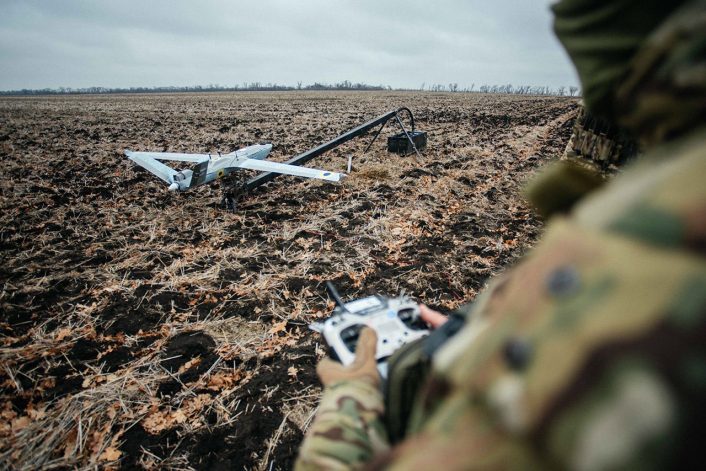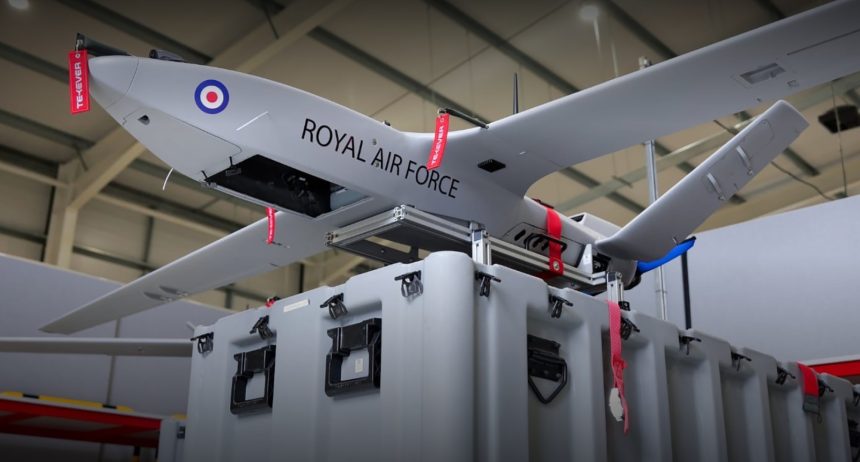Fitted with Leonardo’s BriteStorm EW suite, StormShroud drones are based on the Tekever AR3 platform and officially entered Royal Air Force service on May 2, 2025.
The announcement was made as UK Prime Minister Keir Starmer visited a Leonardo UK facility in Luton, Bedfordshire, where BriteStorm is manufactured. They will be operated by 216 Squadron with support from the RAF Regiment. 216 Squadron reformed as an unmanned aircraft unit in 2020 but, as of 2024, had not completed any drone testing or evaluation.
Introducing a new uncrewed aircraft into service: StormShroud.
The first of a new family of Autonomous Collaborative Platforms (ACPs), this will revolutionise the RAF’s advantage in the most contested battlespaces.
Full story: https://t.co/VWIpSQt8CN pic.twitter.com/M4xP6iXiZQ
— Royal Air Force (@RoyalAirForce) May 2, 2025
StormShroud drones are intended to operate alongside combat aircraft like the Eurofighter Typhoon and F-35B Lightning II to improve the survivability of manned platforms, drawing the attention of and disrupting hostile radars. However, they will not be carried by fighter aircraft, instead launched from the ground using a portable catapult system. Vertical take-off and landing (VTOL) configurations of the Tekever AR3 are available, although the StormShroud examples shown are not equipped with this capability.
The BriteStorm electronic warfare (EW) suite carried by StormShroud drones is described by manufacturer Leonardo as a low size, weight, and power system designed for integration with attritable unmanned aerial vehicles (UAVs). In total, the system weighs 2.5 kilograms. Integrated transmit-receive modules allow for signal jamming in the A band through J band of frequencies. Development of BriteStorm began in 2017 following major successes with the BriteCloud missile decoy, which uses similar technology.
Modular components and readily reprogrammable system architecture will enable StormShroud units to receive rapid updates and upgrades that will allow it to stay current with emerging threats.
Worth remembering that the Leonardo UK BriteCloud electronic warfare decoy that BriteStorm is based on, is deemed so capable, the US is buying it to protect F-35s. A major British export to US success story. #StormShroud https://t.co/PPfC9T2Bvu pic.twitter.com/V3YtRY1cLL
— Tim Robinson (@RAeSTimR) May 2, 2025
Chief of the Air Staff, Air Chief Marshal Sir Rich Knighton says the introduction of StormShroud is “a seminal moment for the RAF to maintain our advantage in Air Combat and national security,” adding that “autonomous collaborative platforms will revolutionise how we conduct a range of missions, from intelligence gathering to strike and logistical support.”
The RAF has coined the term autonomous collaborative platforms (ACPs) to refer to this new type of drone capability, and intends for StormShroud to be the first of many ACPs introduced. Future drones will likely include much larger aircraft like those proposed by Airbus with flight performance more directly comparable to the fighter aircraft they are designed to support.
StormShroud ACP drone was “Fielded a month ago as a minimal capability” says RAF in press conference – 216Sqn will have 24 air vehicles initially – with Tekever currently producing 100s of AR3s a year with potential to scale up production. #avgeek pic.twitter.com/07EAsIQMG8
— Tim Robinson (@RAeSTimR) May 2, 2025
Tekever Drones
Tekever, headquartered in Portugal, is a specialist UAV company and produces the AR3, AR4, and AR5 drones. The company’s drones have seen extensive use by Ukraine since the 2022 Russian invasion, and the AR3 platform alone has amassed over 10,000 operational flight hours in Ukrainian service.

Current UK operations by the company, which includes UAV manufacturing, are spread across multiple sites, supporting 200 skilled jobs. With the StormShroud contract it is expected these UK operations will expand further, creating up to 1000 more jobs with a £400 million investment over the next five years.
Ricardo Mendes, CEO of Tekever, says “This strategic commitment to the UK is more than an industrial expansion – it is a plan to position the UK to lead the transformation of Europe’s defence landscape by delivering faster, more adaptive capabilities that stay ahead of evolving threats.”
Prior to the RAF’s acquisition of the Tekever AR3 in the form of StormShroud, the UK Government was already an active user of Tekever products with both AR3 and AR5 drones tasked with border patrol by the Home Office since 2019. Based at Lydd Airport in Kent, the AR5 can fly long endurance patrols of the English Channel and use integrated electro-optical/infrared (EO/IR) cameras, radars, and automatic identification system (AIS) receivers to monitor the UK’s southern maritime border and direct search and rescue or border enforcement assets.
https://t.co/Tcyn8wKKTs shows a UK Border Force Tekever drone circling over the Channel looking for migrant boats at the moment. It flies out of Lydd Airport – which grandly styles itself as London Ashford Airport – one of the 10 official London airports pic.twitter.com/5uzAWykONM
— Meirion Jones (@MeirionTweets) August 31, 2020
The British Army’s Watchkeeper UAV has also been employed in this role. The troubled UAV’s early retirement was announced in 2024, although it will seemingly remain in service until at least 2026. Tekever’s AR5 may be one contender in the replacement program, titled Project Corvus. Increased involvement in the UK by the manufacturer, as well as cooperation with Leonardo, as a major UK supplier, can only benefit the company’s chances in future procurement decisions.









